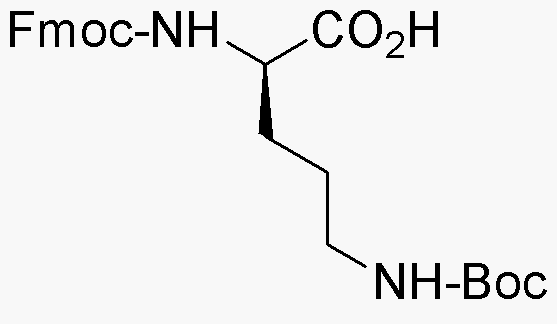Na-Fmoc-Nd-Boc-D-ornithine is widely utilized in research focused on
- Peptide Synthesis: This compound serves as a key building block in the synthesis of peptides, particularly in solid-phase peptide synthesis, allowing researchers to create complex peptide sequences efficiently.
- Drug Development: Its unique structure makes it valuable in the development of peptide-based drugs, offering potential therapeutic applications in various medical fields, including oncology and immunology.
- Bioconjugation: The chemical is used in bioconjugation processes, where it helps attach biomolecules to surfaces or other molecules, enhancing the functionality of diagnostic and therapeutic agents.
- Research in Neuroscience: It plays a role in neuroscience research by facilitating the study of neuropeptides, which are crucial for understanding brain function and developing treatments for neurological disorders.
- Custom Synthesis Services: Many chemical suppliers offer custom synthesis services for this compound, catering to specific research needs, thus providing flexibility and convenience for researchers in various fields.
General Information
Properties
Safety and Regulations
Applications
Na-Fmoc-Nd-Boc-D-ornithine is widely utilized in research focused on
- Peptide Synthesis: This compound serves as a key building block in the synthesis of peptides, particularly in solid-phase peptide synthesis, allowing researchers to create complex peptide sequences efficiently.
- Drug Development: Its unique structure makes it valuable in the development of peptide-based drugs, offering potential therapeutic applications in various medical fields, including oncology and immunology.
- Bioconjugation: The chemical is used in bioconjugation processes, where it helps attach biomolecules to surfaces or other molecules, enhancing the functionality of diagnostic and therapeutic agents.
- Research in Neuroscience: It plays a role in neuroscience research by facilitating the study of neuropeptides, which are crucial for understanding brain function and developing treatments for neurological disorders.
- Custom Synthesis Services: Many chemical suppliers offer custom synthesis services for this compound, catering to specific research needs, thus providing flexibility and convenience for researchers in various fields.
Documents
Safety Data Sheets (SDS)
The SDS provides comprehensive safety information on handling, storage, and disposal of the product.
Product Specification (PS)
The PS provides a comprehensive breakdown of the product’s properties, including chemical composition, physical state, purity, and storage requirements. It also details acceptable quality ranges and the product's intended applications.
Certificates of Analysis (COA)
Search for Certificates of Analysis (COA) by entering the products Lot Number. Lot and Batch Numbers can be found on a product’s label following the words ‘Lot’ or ‘Batch’.
Numéro de catalogue
Numéro de lot/série
Certificates Of Origin (COO)
This COO confirms the country where the product was manufactured, and also details the materials and components used in it and whether it is derived from natural, synthetic, or other specific sources. This certificate may be required for customs, trade, and regulatory compliance.
Numéro de catalogue
Numéro de lot/série
Safety Data Sheets (SDS)
The SDS provides comprehensive safety information on handling, storage, and disposal of the product.
DownloadProduct Specification (PS)
The PS provides a comprehensive breakdown of the product’s properties, including chemical composition, physical state, purity, and storage requirements. It also details acceptable quality ranges and the product's intended applications.
DownloadCertificates of Analysis (COA)
Search for Certificates of Analysis (COA) by entering the products Lot Number. Lot and Batch Numbers can be found on a product’s label following the words ‘Lot’ or ‘Batch’.
Numéro de catalogue
Numéro de lot/série
Certificates Of Origin (COO)
This COO confirms the country where the product was manufactured, and also details the materials and components used in it and whether it is derived from natural, synthetic, or other specific sources. This certificate may be required for customs, trade, and regulatory compliance.


